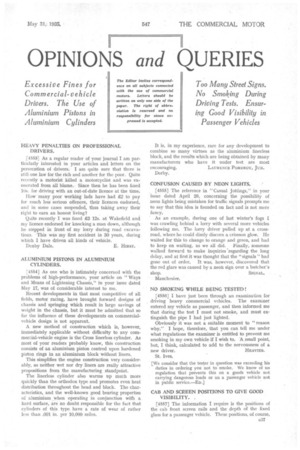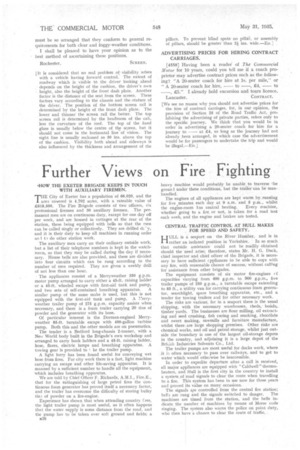OPINIONS and 6UERIES
Page 55

Page 56

If you've noticed an error in this article please click here to report it so we can fix it.
Excessive Fines for Commercial-vehicle Drivers. The Use of Aluminium Pistons in Aluminium Cylinders Too Many Street Signs. No Smoking During Driving Tests. Ensuring Good Visibility in Passenger Vehicles
HEAVY PENALTIES ON PROFESSIONAL DRIVERS.
[45,53] As a regular reader of your journal I am particularly interested in your articles and letters on the persecution of drivers. I am quite sure that there is still one law for the rich and another for the poor. Quite recently a motorist killed a motorcyclist and, was exonerated from all blame. Since then he has been fined itls. for driving with an out-of date licence at the time,
How many poor working lads have had £2 to pay for much less serious offences, their licences endorsed, and in some cases suspended, thus taking away their right to earn an honest living?
Quite recently I was fined £3 12s. at Wakefield and my licence endorsed for knocking a man down, although he stepped in front of my lorry during road excavations. This was my first accident in 30 years, during which I have driven all kinds of vehicle.
Denby Dale. E. HIRST.
ALUMINIUM PISTONS IN ALUMINIUM CYLINDERS.
[4554] As one who is intimately concerned with the problems of high-performance, your article on " Ways and Means of Lightening Chassis," in your issue dated May 17, was of considerable interest to me.
Recent developments in that most competitive of all fields, motor racing, have brought forward designs of chassis and springing which result in large savings of weight in the chassis, but it must be admitted that so far the influence of these developments on commercialvehicle design is not apparent.
A new method of construction which is, however, immediately applicable without difficulty to any commercial-vehicle engine is the Cross linerless cylinder. As most of your readers probably know, this construction consists of an aluminium piston centred upon hardened piston rings in an aluminium block without liners.
This simplifies the engine construction very considerably, as neither wet nor dry liners are really attractive propositions from the manufacturing standpoint.
The linerless cylinder also warms tip much more quickly than the orthodox type and promotes even heat distribution throughout the head and block. The characteristics, and the well-known good bearing properties of aluminium when operating in conjunction with a hard surface, are no doubt responsible for the fact that cylinders of this type have a rate of wear of rather less than .001 in. per 10,000miles. It is, in my .experience, rare for any development to combine so many virtues as the aluminium linerless block, and the results which are being obtained by many manufacturers who have it under test are most
encouraging. LAURENCE POMEROY, JUN. Derby.
CONFUSION CAUSED BY NEON LIGHTS. •• [4555] The reference in "Casual jottings," in your issue dated April 26, concerning the possibility of neon lights being mistaken for traffic signals prompts me to say that this idea is founded on fact and is not mere fancy.
As an example, during one of last winter's fogs I was crawling behind a lorry with several more vehicles following me. The lorry driver pulled up at a crossroad, where he could dimly discern a crimson glow. He waited for this to change to orange and green, and had to keep on waiting, as we all did. Finally, someone walked forward to make inquiries 'regarding the long delay, and at first it was thought that the "signals " had gone out of order. It was, however, discovered that the red glare was caused by a neoh sign over a butcher's shop. SIGNAL. Manche-sit-1% NO SMOKING WHILE BEING TESTED!
[4556] I have just been through an examination for driving heavy commercial vehicles. The examiner entered my vehicle as passenger, and then informed me that during the test I must not smoke, and must extinguish the pipe I had just lighted.
Obviously it was not a suitable moment to "reason why." I hope, therefore, that you can tell me under what regulations the examiner is entitled to prevent me smoking in my own vehicle if I wish to. 'A small point, but, I think, calculated to add to the nervousness of a new driver. HEAVIES. St. Ives.
[We consider that the tester in question was exceeding his duties in ordering you not to smoke. We know of no regulation that prevents this on a goods vehicle not carrying dangerous loads or on a passenger vehicle not in public service.—En.] CAB AND SCREEN POSITIONS TO GIVE GOOD VISIBILITY. , [4557] The information I require is the positions of the cab front screen rails and the depth of the fixed glass for a passenger vehicle. These positions, of course, B37 must be so arranged that they conform to general requirements for both clear and foggy-weather conditions. I shall be pleased to have your opinion as to the best method of ascertaining these positions.
Rochester. SCREEN.
[It is considered that no real problem of visibility arises with a vehicle having forward control. The extent of roadway which is visible to the driver looking ahead depends on the height of the cushion, the driver's own • height, also the height of the front dash plate. Another factor is the distance of the seat from the screen. These factors vary according to the chassis and the-stature of the driver. The position of the bottom screen rail is determined by the height of the front dash plate. The lower and thinner the screen rail the better, The top screen rail is determined by the headroom of the cab, less the curvature of the roof. The top of the fixed glass is usually below the centre of the screen, but it should not come in the horizontal line of vision. The sight line is usually reckoned as 30 ins, above the top of the cushion. Visibility both ahead and sideways is also influenced by the thickness and arrangement of the pillars. To prevent blind spots no pillar, or assembly of pillars, should be greater than 21 ins. wide.—E.; ADVERTISING PRICES FOR HIRING CONTRACT CARRIAGES.
[4558] Having been a reader: of The Commercial Motor for 10 years, could you tell me if a coach proprietor may advertise contract prices such as the following? "A 20-seater coach for hire at 1s. per mile," or "A 20-seater coach for hire, to —, £4, --to --, £5." I already hold excursion and tours licence.
Lancaster. CONTRACT.
[We see no reason why you should not advertise prices for the hire of contract carriages, for, in our opinion, the provision of Section 25 of the Road Traffic Act, prohibiting the advertising of private parties, refers only to the specific journey. We think that you would be in order in advertising a 20-seater coach for him for a journey to — at £4, so long as the journey had not already been arranged, in which case the advertisement would be for passengers to undertake the trip and would be illegal—En. j




































































































